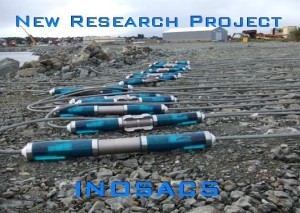I nvestigation and optimization of OBC sensor array coupling to the seafloor
nvestigation and optimization of OBC sensor array coupling to the seafloor
The most important challenge for the oil-industry is to increase the recovery rates for existing fields and to map fluid movements with time-laps 4D seismic, reducing geo-hazard like cap-rock integrity, subsidence or to monitor CO2 storage in an offshore reservoir by using active and passive sources (e.g. Airgun-survey and passive/microseismic). The seismic equipment is configured as sensor lines with cables trenched and covered on the sea-bottom.
The equipment typically comprises up to 4000 sensor nodes depending on the aerial extent of the reservoir. The system will preferably be connected directly to onshore operation centers by means of broadband communication and data can be controlled and processed for QA purposes in real time. Traditional 4D seismic techniques re-shoot a specific reservoir using conventional towed streamer techniques, trying to map and assess changes in the reservoir by having a repeat interval of 2-3 years.
I started in September 2010 a new research project in cooperation with Octio Geophysical AS and the University of Bergen and this project was successfully finished in October 2013.
There will be two main objectives for this project. The first will be a systematic investigation of OBC coupling to the seafloor for a better understanding of the horizontal coupling mechanism to increase the signal quality for 4D seismic, micro/passive seismic and fluid flow in a reservoir by injection of water or super critical CO2.
The second objective is to design a new OBC sensor-housing (node) to improve the coupling and a test on a real reservoir in cooperation with a costumer or in an addition research project.
In order to improve sensor coupling in the offshore environment novel and systematic approaches are needed. Today several approaches exist for the vertical component of a three component sensor. But there are no systematic investigations for the horizontal components. Most of the vertical approaches use special pre-processing methods like separation of upgoing and downgoing P and S wave-fields or inverse filtering.
But to understand the sensor coupling to the seafloor it is essential to investigate the sensor coupling itself. or a systematic investigation it is substantial to understand the connection f different sensor-housing designs to variable seafloors. Which design makes the sensor coupling better and why? What influence has the seafloor oil conditions and how deep should an OBC be trenched and how strong is he cable-tension influence? Why is the sensor coupling different for all three components? All these questions will be investigated by using simulations and doing tests in a water-tank. The water tank will be hanged to the floor to decouple the water-tank from the ambient noise.
The most critical challenges will be to simulate the correct soil coupling with the sensor-housing for horizontal movements, because current models its not into measurements and can only be seen as a start model. To find the optimal mechanical node design is also a critical challenge, because of to integrate the new design into the offshore installation procedures